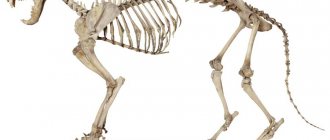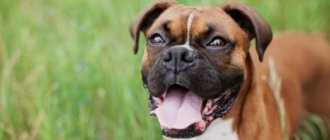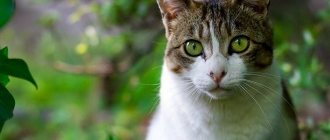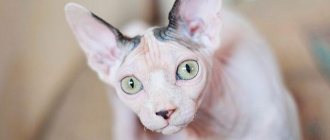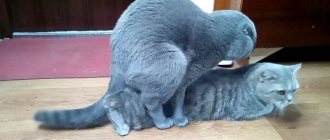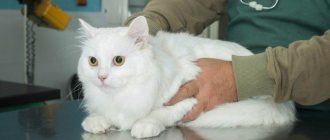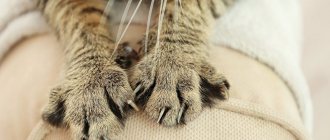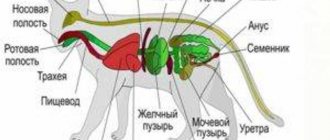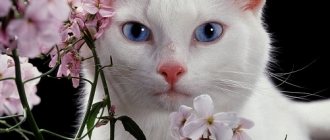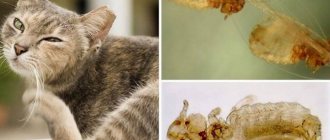How many fingers does a cat have?
A person has five fingers on his feet and hands. How much does a cat have? At first glance, there are four on the apron and hind legs.
But, if you take the front paw in your hands, a spiny formation can be felt a little higher. This is the fifth finger. Evolution left it for cats to climb trees.
It is known that people have abnormalities; fingers may be missing from birth. This condition is called ectrodactyly. When there are more fingers than normal, they talk about polydactyly. Art lovers imagine that in Raphael's famous painting Pope Sixtus II is depicted with six fingers.
Standard norms
First of all, it is worth noting that pets, like people, sometimes experience various deviations from the norm. But how many toes should there be normally? It is believed that there should be 18 of them in total. It is this figure that is fixed by international felinological organizations as a standard.
Wherein:
- The front paws have 5 toes, 4 of which are located next to each other and touch the ground while walking, and 5 is considered rudimentary and is located slightly higher, used only when moving on inclined and vertical surfaces.
- There are 4 toes on the hind legs.
Each of the fingers has a soft, non-hairy pad and a sharp sickle-shaped claw, which allows them to deftly climb trees, defend themselves from attacks by other animals and firmly grasp prey.
At the same time, cats have retractable claws: due to the work of muscles and tendons, they are retracted into a kind of skin sheath, so they do not interfere with movement. But when the need arises to grab something, the animal spreads its fingers and releases its dangerous “weapon.”
It is the fingers that are involved in the process of walking and running; due to their flexibility and mobility, cats are able to move their limbs in any direction. This paw structure allows you to maintain balance even on the narrowest surface, as well as move quickly and almost silently, which is important for predators, which include domestic cats.
The sharp contraction and relaxation of the digital flexors allows these animals to jump to impressive heights.
Physiological characteristics of cat paws
Cats have different numbers of toes on their hind and front paws. There are four of them at the back and they are placed on the same line. There are five on the front ones, one of the fingers is higher than the others, and does not touch the floor, set slightly to the side. The cat needs it when moving on inclined or vertical surfaces.
Each finger ends in a claw. In a calm state, it is hidden inside a leather trench, for example, when walking, in order to move silently. And if necessary, the animal releases it outside (for protection, attack).
Cats' claws are curved and sharp.
How to care for cat paws
All cats instinctively take great care of their paws, and the owners’ task is to help them do this as much as possible. Even a very minor injury - a scuff, crack or scratch on the pads of the fingers can greatly unsettle your pet: he will become irritable or, conversely, depressed, and lose his appetite. In addition, wounds in this area are extremely painful, and sensitive cats suffer greatly from them.
The causes of injury to the pads of the paws and fingers can be very different:
- physical - cuts from sharp objects at home or while walking;
- thermal - cats often get burns by jumping, for example, on a hot stove, and in extreme cold, frostbite occurs on their fingers;
- chemical - if an animal walks in the snow in winter, then the substances that are sprinkled on it may cause a chemical burn on the foot;
- improper nutrition - unbalanced, poor-quality feeding leads to cracking of the skin on the pads and the appearance of weeping ulcers.
Even a minor finger injury can have serious consequences.
Some skin and internal diseases or severe stress can also negatively affect the condition of cat fingers. Such problems require diagnosis and comprehensive treatment under the supervision of a veterinarian.
To eliminate the problem, you need to identify its cause in a timely manner, and for this you should periodically carefully examine your pet’s paws. And at the slightest violation of the skin on the pads and fingers, immediately wash and heal the wounds. It is also very important to constantly monitor the condition of the claws - make sure that they do not grow too long, do not split or get injured.
Trim your cat's claws promptly
An excessively overgrown claw or neglected injuries are common causes of inflammatory processes, which in some cases can even lead to amputation of a finger.
If your cat does not wear down her claws naturally, she will need to have her nails done by herself or by a veterinarian as they grow back. To prevent your pet from damaging upholstered furniture and wallpaper with its claws, just buy him a good scratching post or make one yourself from scrap materials - it’s not difficult at all.
Buy your cat a good scratching post
In polydactic cats, the claws on the “extra” toes grow at a faster rate than on regular toes. This must be taken into account in order to adjust their length in a timely manner.
Video: DIY scratching post - it's easy
Anomalies in the development of fingers in cats: what to do
In some animals, a gene mutation is observed - polydactyly, in which the number of fingers exceeds the norm. Moreover, this is not the result of modern selection. Medieval sailors considered it lucky to have a multi-toed cat on board a ship. The extra scratches help him stay on the deck while rocking and hunt rats.
Among Maine Coon animals, an increased percentage of polydactyl individuals is noted. They are considered native to the northeastern United States. The settlers, who called the reclaimed lands New England, noted that wild cats are distinguished by their agility, and their paws do not sink in deep snow. American President Theodore Roosevelt installed a multi-toed cat in the White House.
Multi-toed cats look funny, and if the anomaly does not bother them, no treatment is required. In some cases, if the claws injure the surrounding surfaces, then the animal can be shown to a veterinarian, who will conduct an examination and decide what to do - trim the claws regularly or remove excess scratches.
With ectrodactyly, the paw looks ugly and prevents the cat from moving normally. The anomaly is corrected surgically.
A little about ectrodactyly in cats
We talked about polydactyly. Can animals suffer from ectrodactyly? Unfortunately, yes, they can. But fortunately for owners, this disease is very rare in cats. With ectrodactyly, the fingers are smaller than normal and look unusual, and the cat's paw looks like a claw. With this problem, animals experience great problems with motor activity, cannot fully walk and run, climb to heights and land.
And if previously the only way out of the situation was amputation of an abnormally constructed limb, now there is hope for saving the animal from such a radical intervention. In any case, ectrodactyly in dogs in our country has already begun to be corrected surgically, by cutting the front or back paw as correctly as possible so that the animal can move normally.
Finger functions
Toes are especially important for cats, as they perform functions such as jumping and silent movement. In addition, with their help, animals feel the texture of the surface and maintain balance. All this is possible thanks to the huge number of nerve endings located in the pads.
The receptors help cats detect subtle vibrations, which affects their ability to seek out prey such as mice.
This increased sensitivity also has a downside. Cats react acutely to changes in temperature and pressure. When the pads are damaged, they experience severe pain, so they can become irritable and aggressive. Cat owners should examine their pets' paws every day, this will help prevent health problems, and if wounds or other damage are found, provide assistance.
Cat's fingers: structural features and functions
Cats are predators by nature, so nature rewarded the furry hunters with well-developed fingers. Silent walking, graceful jumps, dexterous conquest of trees and other heights are the merit of cat fingers.
A cat's toes are made up of bones, tendons, phalanges and a claw.
Cats owe their quiet movement to their tiptoe walking. They do not rest on the entire foot. Therefore, there is a hard pad under the toes and in the center of the paw, which reduces the pressure when walking.
Pads soften the stress on your fingers
Cats' paws contain their main weapon - claws. The claws continue the phalanx of the finger, which is hidden in a leather pouch. Tendons and ligaments pull them into the pouch, allowing the cat to walk quietly. The claws look menacing, but at the same time they are very sensitive due to the nerve endings. Therefore, damage to the claw can cause severe pain to the animal.
Contraction of the phalanges of the fingers and their sharp straightening allows the cat to jump high.
Graceful cat jumps are the merit of their fingers
And these are not all the functions for which a cat’s fingers are responsible:
- Balance and sensitivity. Nerve endings in their fingers help cats detect the slightest vibrations. Thanks to this, the cat can sense the movement of small prey.
- Sustainability. Thanks to the development of each finger, the cat can easily climb trees and maintain balance even in an upright position.
The structure of the toes allows cats to climb trees
- Depreciation. Hard pads soften the load when jumping.
- Temperature regulation. The pads are the only part of a cat's body that have sweat glands. They act as a thermostat.
Paw pads regulate body temperature
- Communication with other animals. Between the cat's toes are glands that secrete scent. By scratching a post or fence, the cat leaves it on the surface and declares its rights to the territory to other animals.
Interesting Facts
- do not see kittens with fewer toes , since they necessarily have another severe pathology in the development of internal organs, leading to death soon after birth.
- Zoological scientists are breeding a breed of cats with polydactyly - Maine Coon, they have 6 toes on their hind paws.
- When walking or running, an animal rests on only 4 fingers , no matter how many there are.
Those with extra toes and claws live well in the wild; this quality helps stray cats not only to get food, but also to protect themselves from other relatives or uninvited guests
What breed of cat has an extra claw?
The largest domestic cats, the Maine Coon breed, have an extra claw. This is not a pattern, but rather an anomaly, but, fortunately, it does not cause inconvenience or harm. Simply, according to breed standards, such an individual is considered defective.
In fact, if you are not going to show with your pet, it doesn’t matter at all. Cats of this breed, regardless of the presence or absence of an additional claw, are very attentive, intelligent, friendly, attached to children, obedient, and completely unpretentious in food or care in general.
Sources:
https://dogcatfan.com/518-skolko-palcev-u-koshek.html
https://kotguru.ru/skolko-kogtej-u-koshek-i-uxod-za-nimi/
https://womanadvice.ru/skolko-kogtey-u-koshki
Permission to breed
Since 2008, there has been a campaign to recognize multi-toed Maine Coons, and many organizations (CFA, TICA, CFF, ACFA) confirm their club status. This is happening against the backdrop of the growing popularity of the breed and increased interest in such cats among lovers.
Breeders who specialize in breeding Maine Coons with the mutation should be aware that it is caused by a gene passed directly from the parents. After a generation, this mechanism does not work.
Only the presence of a parent with polydactyly in mating allows one to expect offspring with an unusual paw structure. This is only 40-50% of the cubs, which makes kittens with this feature exotic.
Admission to breeding maine coon polydact is issued, in addition to the above organizations, by the American TICA and the New Zealand NZCF. The pedigree of mutation carriers must include the letter P (or Pd - designation of the polydactyl gene).
Possible anomalies
Gene mutations are characteristic of all multicellular organisms, and they are also found among cats. An abnormal number of toes can occur in both male and female cats. This genetic disorder is inherited. If at least one of the parents is polydactic, then the probability of having multi-fingered offspring is very high. “Extra” toes can be on one kitten’s paw, on several, or on all four at once.
Even if there is only one “extra” toe on one leg, then this is definitely nothing more than a manifestation of the polydactyly gene. This structural feature is not considered a genetic deformity, does not affect health, and does not bring any discomfort to the animals. The only negative is that such animals cannot participate in exhibitions due to non-compliance with exhibition standards, which no one will regret if the cat is healthy, energetic and beautiful. When examining newborn kittens and discovering a “special” kitten, it is recommended to contact a felinologist and find out the prognosis for the development of the animal with the identified anomaly.
Interesting facts about cats' paws and toes
Did you know that cats can also be left-handed or right-handed , using their paws and toes to varying degrees? Moreover, recent studies by German and French veterinarians have proven an amazing fact: it turns out that many cats have “preferred” paws. Simply put, some right-handers still prefer to use their left paw when hunting mice.
Experts from Queens University (Ireland) suggest that the division into right-handed and left-handed animals among animals largely correlates with gender. It is believed that among cats there are more left-handers, while among males right-handers predominate. Interestingly, humans (as well as other primates) have exactly the same “gender” division.
You can easily find out which group your pet belongs to: just watch which paw he uses to fish out a treat from under the furniture. In addition, you can simply play with the cat using a bow on a string for this purpose.
The role of fingers in walking
Another interesting fact - it turns out that cats walk... on their fingers. The paw pads, contrary to popular belief, are practically not involved in the process of walking and running. It is the flexibility of the fingers that allows cats to move so quickly and gracefully.
Due to the contraction of the flexors and their sharp relaxation, cats can make impressive jumps. Finally, due to the “finger” movement, these animals can walk very quietly (almost inaudibly), which is also ideal for all nocturnal predators, which are what domestic cats are.
The role of fingers in tactile sensitivity
Have you ever wondered why cats constantly “feel” with their paws any things and objects that somehow aroused their interest? It's all about the incredible sensitivity of the fingertips. They are literally riddled with nerve endings. Moreover, the latter help the animal not only feel the texture of the surface on which the cat walks, but also participate in maintaining balance. In addition, the receptors are incredibly sensitive: it is known that the pads of a cat's fingers can feel even such minor vibrations that occur when moving mouse-like rodents.
Big-footed intellectuals
Many owners of multi-toed cats, especially Maine Coons, note that their pets have remarkable intelligence, comparable to that of a human. Polydacts have a very special relationship and mutual understanding with the members of the family in which they live, bordering on telepathy.
Such animals should only be owned by those who are not prejudiced against having extra toes. Some people perceive such an anomaly as a deformity, while others, like many centuries ago, see a mystical meaning in this.
In fact, this is just a feature of appearance.
What is polydactyly
Sometimes it happens that a cat is born with a few extra toes. This is a genetic trait called polydactyly.
The extra fingers may be aligned with the other four or spaced apart from them, like a human's thumbs. The first option is called postaxial polydactyly, and the second is called preaxial. Paws with spaced toes are called “mittens”, and wide multi-toed feet are called “snowshoes”. Neither one nor the other form of polydactyly causes the slightest harm to animals.
inconvenience. This is not a deformity, but only a structural feature.
An abnormal number of toes can be present in both male and female cats. Most often, this phenomenon occurs on the forelimbs or simultaneously on the front and hind limbs. Cases of hind limb polydactyly are extremely rare.
Types of polydactyly in cats
Phenotypic manifestations of polydactylism are varied:
- Fully functional and full-size extra fingers . With this structure, the extra fingers are fully formed, move voluntarily under the control of the brain, and have bony phalanges with joints, a pad and a claw.
- Physically underdeveloped, deformed extra fingers . In this case, the lateral fingers are thin, shortened, curved with the presence of additional phalanges. Sometimes there is a whole additional bone structure, similar to the fork of the branches and comparable in area to the main group of fingers. For example, from one full-sized additional finger grows a thin, curved one with two additional phalanges.
- Bone outgrowth . A similar defect is revealed by palpation of the paw and on an x-ray, representing an additional tubercle on the bone of one of the fingers.
- Additional claw . Between fully functional fingers there may be free claws that are not controlled and not retractable, and therefore dangerous for the animal itself. With extra thumbs they talk about preaxial polydactyly, with extra little fingers - postaxial. In cats, the most common form is the preaxial form: in appearance, this paw resembles a mitten.
Features of walking of cats and cats
Cats are characterized by digital walking. This is probably why their gait is so silent. In addition, they place their hind paws in the place where their front paws stepped. This allows them to reduce the number of visible marks.
But these animals have another interesting feature. Cats are pacers.
Ambling is the simultaneous forward movement of the front and rear legs on one side, that is, left-left, right-right.
The peculiarity of this gait greatly increases the speed of movement and provides greater stability during sudden changes of direction.
The cat walks, moving its paws forward first on one side, then on the other.
Positive and negative properties of polydactyly
Polydactyly has many advantages:
- A cat with extra toes can be easily held on any surface;
- Can move quickly in the snow or swim;
- Uses door handles freely for their intended purpose;
- It walks completely silently and can sneak up very close to its prey;
- With great dexterity, he catches fish in a stream or home aquarium.
However, in some cases, a completely different gene may be responsible for the development of polydactylism - the one that causes deformed limbs in cats, bent joints, and ingrown claws. Such animals require treatment at a veterinary clinic.
The most dangerous deviation is a thumb with three phalanges. Animals with this defect may give birth to underdeveloped kittens. Individuals with three-phalanx fingers are subject to mandatory
sterilization.
Usually the gene that is responsible for the presence of polydactyly is inherited. If at least one of the parents has more fingers than normal, some of the offspring will necessarily be multi-fingered. But since this is a recessive gene, the remaining kittens will have completely normal legs.
